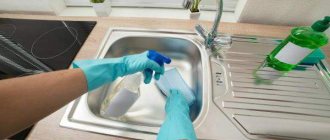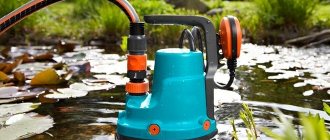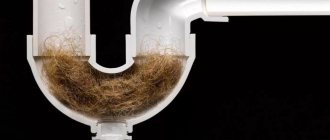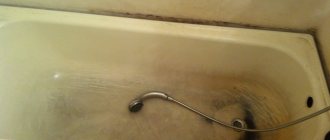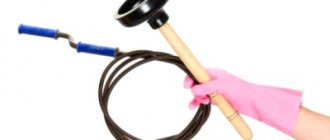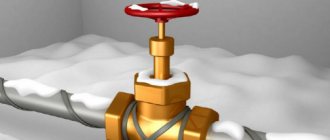Determining the location of the blockage
A clogged pipe is a fairly common problem, and if you encounter it, you should not panic and look for the phone number of a plumber. Very often you can handle it yourself, saving time and money.
Before cleaning pipes, it is important to understand where exactly the blockage has formed. This directly affects the choice of method to solve the problem.
To determine the approximate location of the blockage, open the water and see how it “disappears”:
- The water decreases very slowly - most likely, the plug is more than a meter away from the drain. In case of such a problem, the best way is to use a special metal cable.
- The water drops to a certain level , and then everything remains unchanged - the blockage is located in the area from the siphon to the first turn. In this case, it will be enough to use either traditional methods or chemical means.
- The liquid does not leave at all - in 90% of cases the siphon turns out to be clogged with fatty deposits. The best option to deal with contamination is to manually clean the pipeline.
These are the most common ways to identify where the problem is.
Most often, traffic jams occur at the places where the pipe first turns, narrows, or connects to the central riser
Once you have found out exactly where the blockage has formed, you can begin to remove it.
How to determine its location and type?
Most often, sewerage becomes clogged in siphons and at the junction of pipes with angles and tees. Blockages are divided into three types:
- Local, in which water stagnates in only one place, for example, in a bathroom or sink.
- Common when there is water in both the bathroom and the sink.
- Global, in which the liquid does not pass through all pipes.
Local blockage can be determined without problems, since most often it is concentrated in the place of the water seal of the plumbing fixture, that is, in the siphon area.
Finding the location of a common blockage is also not difficult . For example, if there is water in the sink and in the bathroom, but leaves the toilet well, then it has formed in the lounger in the area between the bathroom and the toilet.
A global blockage blocks the entire sewer drain at the farthest point. This is the most serious problem, which often requires calling a specialist. He will determine the location of the blockage using a flexible tube with a camera at the end.
There is another way to determine the point of blockage. To do this, turn on the water in an empty sink or bathtub and wait until it begins to rise from the drain hole.
If this happens after 2-5 seconds, then the siphon or the area closest to it is clogged. When the plug is further away, it takes a little longer for the water to flow into the pipe. An obstruction of the common riser is indicated by a rise in water in all plumbing fixtures in the apartment.
The following types of blockages are distinguished:
Operational with localization in the pipe , in which it becomes clogged with food debris, hair, dust, and grease. These substances inevitably end up in the drain in any apartment.- Operational with localization in the siphon . Most often it is represented by small debris.
- Mechanical. It can occur unexpectedly, for example, when large debris gets in, or gradually, when it slowly and systematically accumulates inside the pipe.
- Technogenic. This blockage is due to errors made in the design of the drainage system.
Popular folk methods
To clear a blockage in a pipeline, improvised means are well suited. If the problem is caused by the accumulation of fat, then you can try to free the drain from the plug with plain water.
In the case of steel pipes, boiling water works well with fat deposits - you need to pour it for 20 minutes. For plastic plumbing, hot water is used, but not more than 70 °C.
Running water under strong pressure will help you check whether the problem has been resolved or not.
Method number 1 - baking soda
Sodium carbonate or baking soda, which is familiar to all of us, will help to cope with the blockage of fat deposits in the pipes. It is better if it is domestically produced, since imported analogues are not very effective.
First you need to pour 200 g of baking soda into the drain hole. Next, add 200 ml of vinegar and close the hole tightly. The reaction between the substances will effectively dissolve the grease, removing the blockage. After waiting 10-15 minutes, open hot water under high pressure for a couple of minutes.
To increase efficiency, heat the baking soda in a frying pan before using it. It should acquire a golden color. It is important not to overexpose the component over the fire, otherwise it will lose its properties.
This method is effective only in cases of “fresh” blockages. If they are already old, you will have to use more caustic substances.
Method No. 2 - caustic soda
In the fight against old or severe pollution, you can use a more caustic agent - caustic soda, which can be purchased at any hardware hypermarket.
Take a large metal bucket and put 2-3 kg of caustic soda into it with a plastic scoop. Pour the substance into 12 liters of cold water. Stir the component for 30 minutes. Be as careful as possible so that the solution does not come into contact with your skin. It is necessary that the soda dissolves completely.
Place the bucket on the fire and heat the mixture to 70 °C. It is important not to overexpose the solution, otherwise it will lose its effectiveness. In addition, extremely hot liquid can damage pipes.
Slowly pour half the mixture down the drain and leave for 2 hours. After the specified time, pour out the remaining mixture and wait again for 2 hours. Rinse the drain pipes thoroughly with hot running water.
As housewives note in reviews, caustic soda allows you to cope with even severe blockages the first time. The main thing is to adhere to the proportions and wait the specified time.
It is strictly not recommended to use caustic soda to clean a plastic pipeline from contaminants, as it can corrode the pipeline
Gel caustic soda is more gentle. You can also purchase it at hardware stores. The cost of gel soda is slightly higher than regular soda. And in terms of efficiency, they are practically not inferior to each other.
To clean the pipeline, take 100 ml of the component, pour it into the hole, and then add 250 ml of hot water. Wait 2 hours, then rinse the pipes thoroughly with hot running water.
Method number 3 - soda, vinegar and chlorine
Vinegar, soda and chlorine will help deal with severe stains. All these substances will probably be found in the bins of any housewife. The latter component is not entirely harmless to people, but it allows you to effectively deal not only with fatty deposits, but also with limescale deposits in the water supply.
First of all, remove the water from the sink - excess liquid will reduce the effectiveness of the product. Pour 50 g of soda ash and baking soda into the drain. After 30 minutes, pour in 150 ml of vinegar and 150 ml of chlorine.
Be sure to plug the hole tightly to avoid the appearance of pungent and unpleasant odors in the room. After 30 minutes, open the warm water and leave it for 40 minutes.
Method number 4 - coarse salt
If the problem occurs in cast iron pipes, then coarse salt and boiling water will help to cope with it. You can use vinegar essence as a “reagent”, but finding it now is quite problematic.
Please note that regular Extra salt is not suitable for removing blockages. Due to the small granules, it does not allow effective dissolution of fatty contaminants.
To begin, pour 300 g of coarse table salt into the drain hole. Add 2 liters of boiling water, 100 ml of 70% vinegar, wait 30 minutes and check the result. Don't worry if you didn't succeed the first time, you may have to repeat the procedure several times.
Method No. 5 – citric acid
Citric acid works great for removing lime deposits in pipes. It has repeatedly proven its effectiveness. Housewives note that the product allows you to cope with the problem even the first time.
First, pour 100 g of citric acid into the drain hole and fill the component with 250 ml of boiling water, and after 20 minutes open the hot water.
Instead of citric acid, use the juice of fresh lemons. Take 100 ml of it and pour it inside the drain. Leave the product for 1 hour and then run running water.
We also recommend reading our other article, where we talked in detail about how to clean a toilet from limescale. Read on for more details.
Method number 6 - salt and soda
To dissolve the fat plug, use soda and salt. Take 300 g of each component, mix and dissolve in hot water - you need to get a highly concentrated solution. It is important to achieve complete dissolution of the components.
Pour the mixture down the drain and wait 15 minutes and turn on the water briefly. If you cannot solve the problem the first time, perform the procedure again. Only this time, add an additional 15-20 ml of vinegar to the finished composition.
Method No. 7 - Alka-Seltzer tablets
Instead of soda and salt, you can use Alka-Seltzer effervescent tablets. They have repeatedly proven their effectiveness.
The effervescent reaction of the tablets, provoked by the addition of vinegar and water, helps to quickly and effectively dissolve even quite strong stains
To remove the plug you will need to take 2 tablets and place them in the drain. Pour the tablets with a glass of vinegar and 50 ml of water. Leave everything for a couple of minutes and then rinse with hot water.
Please note that Alka-Seltzer tablets are sold in regular pharmacies. They are affordable and available without a prescription.
Method No. 8 - washing powder
To combat light stains and prevent blockages, housewives use washing powder. Agree, it will definitely be found in every home.
To combat blockages, it is important to use granular, rather than liquid, laundry detergent. Only the first option will help to effectively solve the problem.
It is taken in the amount of 2 measuring spoons and poured into the drain. Next, turn on hot running water for 5 minutes. After this time, the plug should disappear.
Cleaning a sink or sink drain
There are four cleaning methods that will help you quickly clear a clogged drain.
Boiling water
Some people prefer to get rid of blockages using hot boiled water. This method is only suitable for cleaning cast iron or metal pipes. It is contraindicated to pour boiling water over plastic structures, as this can damage their surface.
Before you start clearing the blockage, you need to familiarize yourself with the features of using this method. Water is poured in a small stream for 5-8 minutes. To quickly get rid of dirt and grease, you can add a little soap solution to the water.
Soda and salt
Sometimes a special solution made from salt and soda is used to remove blockages. To create it, you need to add 100 grams of salt and 200 grams of soda to a ten-liter container with hot water. The liquid is boiled for 10-15 minutes, after which it is immediately poured into the clogged drain. Leave the soda-salt solution for 20-25 minutes so that it thoroughly dissolves the blockage. Then it is cleaned with a thick cloth or an ordinary plunger.
Vacuum cleaner
Some experts recommend clearing the clog with a vacuum cleaner. To do this, you need to use models that have an air blowing function.
Before using this difficult method, you should familiarize yourself with the recommendations for using a vacuum cleaner. First, the device pipe is securely sealed with an unnecessary rag. After this, it is carefully installed in the drain hole. The vacuum cleaner is then turned on at full power so that the clog can be blown out. If this does not push through the resulting plug, you will have to clean the drain using another method.
See also
Rules for how to quickly clean a glass-ceramic hob from dirt and grease
Siphon cleaning
Often the cause of difficulty draining water is a clogged siphon. To get rid of it, you will have to remove the pipe yourself and clean it. To do this, unscrew the fastening nut and carefully remove the product. After this, the pipe is unscrewed and cleaned.
There are different ways to clear a blockage in a siphon. If the contamination is not serious, you can simply rinse it in water. In case of serious blockage, the siphon is placed for 2-3 hours in a container filled with hot water and detergent. Then it is rinsed and put in place.
Let's turn to chemicals
If you don’t have time to experiment with folk remedies, then you can use specialized mixtures that are sold in any supermarket, in the household chemicals department. They are affordable and highly effective.
If the drain is completely blocked, purchase products marked “can be used in standing water”, since other options simply will not cope with severe blockages
Let's look at the most popular chemicals used by housewives to remove blockages.
Mole is an affordable solution that is well suited for combating household pollution. Pour 200-250 g into the drain and leave for 2 hours. For old plugs, the liquid can be left overnight.
After the specified time, supply water with strong pressure. If the plug cannot be removed immediately, use the product again.
Debouche is a universal liquid for eliminating mechanical and grease blockages. Directions for use: pour 500 ml of liquid into the drain and leave for 3 hours.
For severe contamination, use twice as much product, and the validity period increases to 10-12 hours. After using Debouche, be sure to rinse the pipes thoroughly with water.
Pothan is a solution for removing any types of blockages in cast iron and plastic pipes. First, you need to lower the water level in the drain by 5 cm. Next, pour 100 ml of the product and 100 ml of boiling water. After 5 minutes, warm water is supplied to the drain.
Mister Muscle is a popular powder for eliminating fat plugs. It penetrates into the most difficult places and, due to its special composition, removes not only clogs, but also harmful bacteria and unpleasant odors. According to the manufacturer, Mr. Muscle copes with the problem in just 5-10 minutes.
When using specialized cleaning products for sewer pipes, it is very important to strictly follow the instructions on the packaging. Otherwise, the active substances of the product may damage the pipeline
Floop is a cleaner that dissolves fatty, organic and hair plugs. The product is quite caustic, so when working with it, be sure to equip yourself with protective clothing, a respirator and rubber gloves.
When adding Floop to a drain hole, it is important to avoid getting it on plumbing fixtures, as well as on exposed body parts or clothing. The product is poured with hot water and left for the time specified in the instructions. Then the drain is washed generously with cold water.
Tiret Turbo is a universal solvent produced in the form of gel and granules. In the first case, it is poured into the drain and left for 5-10 minutes. Using the granular version, it is first poured into the drain, and then 500 ml of hot water is added and left for at least 10 minutes.
It is prohibited to use the latter remedy for longer than the time specified in the instructions. The active substances included in its composition can cause destruction of pipe walls.
There is an article on our website where we examined in detail the best chemicals for cleaning sewer pipes. Read on for more details.
How to quickly remove with special compounds?
If folk remedies do not help solve the clog problem, you can turn to household chemicals. There is a wide range of pipe cleaners available in stores. To choose the right composition that will not harm the water supply, you need to take into account the following points:
Powders. They are represented by highly concentrated acids and alkalis.
They are poured into the drain, filled with a small amount of water and left overnight. In the morning the pipes are washed. The advantage of such products is the low price, and the disadvantage is the inconvenience of use.When poured into a drain, some of the powder may spill out, harm plumbing fixtures and damage rubber gaskets.
In addition, if you pour too much water into the pipe, the powder will simply be washed away into the general drain, and the blockage will remain in place. This often happens when dirt narrows the opening of the pipe rather than blocking it.
- Liquid products . They are represented by less concentrated solutions of acids and alkalis. They are simply poured into the pipe and left to act for the time specified in the instructions. Such compositions are more expensive than powders, but they are more convenient to use. However, if water remains in the pipe, it will reduce the concentration of the substance, and it will be ineffective.
- Gels. They are poured into the pipe, left for a while and washed off with clean water. Due to their viscous consistency, they stay inside longer, so they dissolve blockages more effectively. These are the most effective, but also the most expensive formulations.
When choosing a product, you need to carefully study the label to clarify what type of pipes it is suitable for. The composition may contain alkalis, acids, surfactants and flavors. By reacting with deposits, the active substances dissolve them, promoting cleansing.
To clean kitchen pipes, it is better to choose alkali-based compounds, as they dissolve fats more effectively. Acid-containing products are poured into the bath, which quickly deal with hair, threads, animal hair, etc.
Top 3 best drugs
Effective pipe cleaners:
Sanfor gel
Gel for pipes, for complex blockages. The composition is suitable for processing any pipes, helps eliminate odors, destroy bacteria, and contains chlorine . Price – 100 rubles. Read reviews here and here.
How to clean pipes with Bagi Pothan granules?
The product is safe for metal and plastic pipes and effectively dissolves grease and hair. For one treatment, use 100 g of granules and 100 ml of hot water. Exposure time – 3 minutes. Price – 450 rubles. Read reviews here, on this and this review site.
Mole Turbo
The product cleans and disinfects pipes, helps eliminate unpleasant odors and treats surfaces antibacterially. Contains chlorine . Price 120 rubles. Reviews can be found here, here and here.
Radical solutions to the problem
When the blockage cannot be eliminated using folk remedies and chemicals, you should try to deal with it using mechanical methods.
Option No. 1 – vacuum cleaner
You can use a vacuum cleaner to remove clogs. However, the device must have a blowing function. If you are the owner of such equipment, then first wrap the end of the device hose with a loose rag. It is very important to fix it well.
Press the hose firmly against the drain hole and turn on the vacuum cleaner to maximum. A powerful stream of air will push out the plug formed in the pipe.
It is necessary to install the device tube at a right angle, trying to press its end as firmly as possible against the drain hole
Using a vacuum cleaner is effective when the problem is no more than 1 meter from the drain hole.
Option No. 2 – plunger
To bleed the drain, use a plunger, which can be manual or mechanical. This device is sure to be found in every home. It helps create strong pressure inside the pipe, causing the blockage to break up or pump deeper.
While pumping, move the plunger back and forth without lifting the bowl from the drain. Do several approaches, and then remove the plunger and evaluate the effectiveness of the work. If the liquid drains slowly, you will have to repeat everything all over again.
Before working with a plunger, it is advisable to lubricate its edges with grease or Vaseline. This will ensure tighter contact with the sink.
Option No. 3 - plumbing cable
When a plug has formed on the bends of pipes or far away in communications, a plumbing cable is used. It can be used to hook and pull out a clog or clear it out.
The process of cleaning pipes with a cable begins with dismantling the siphon. Do not try to work the cable directly through the plumbing drain hole. Only by removing the siphon will you have free access to the sewer system.
After installing the cable in the pipe, begin to screw it clockwise, trying to slowly push it forward. Act smoothly and gradually, avoiding sudden movements.
There is a hook at the end of the cable, so use the device carefully when cleaning plastic pipes so as not to damage them
When you encounter resistance, turn the device until it continues to move. After this, you can put the siphon in place and flush the system.
Not everyone has a plumbing cable, but if you want, you can buy it at any plumbing store.
Read about the types of plumbing cables for cleaning sewers in this material.
In addition, you can build this device with your own hands from a plastic bottle and scrap materials.
The instructions are as follows:
- Cover the bottle from top to bottom with strips of tape to form a spiral.
- Draw lines along the border of the adhesive tape with a colored marker.
- Cut the bottle along the marks you made.
- Be sure to leave the bottom - it will act as a handle.
- Make small cuts along the resulting spiral.
- Insert a homemade cable into the drain and push it through, slowly holding it by the “handle”. Due to the notches, debris will cling to it, this way it will be possible to overcome the traffic jam.
This device is only suitable for plugs that are not too far from the siphon.
During sewer cleaning work, do not forget to periodically turn on the water. This will help you deal with contaminants faster
For blockages at great depths, steel wire with a diameter of 5-6 mm is used. One end of it is bent with a hook.
Option No. 4 - disassembling and cleaning the siphon
As was said at the beginning of the article, in 90% of cases the water does not pass beyond the sink due to a clogged siphon.
The cleaning procedure is as follows:
- Spread an unnecessary rag on the floor that absorbs water well. It should be directly under the siphon.
- Place a basin under the sink into which the liquid will subsequently be drained.
- Unscrew the lock nut that secures the siphon tube.
- Remove the siphon. Remove all dirt from it (this is convenient to do with a brush), and then rinse thoroughly under running water.
- Pour a solution of soda and vinegar into the pipe connected to the sewer. When the reaction is complete, pour in an additional 150 ml of vinegar. Repeat this procedure several times.
- After 15-20 minutes, pour several liters of hot water into the pipe and wait 5 minutes.
- Reinstall the siphon and tighten the lock nut.
As a rule, if you follow the instructions given, you will be able to deal with the blockage the first time.
Mechanical elimination methods at home
There are three mechanical ways to clear blockages.
plunger
Many plumbers use plungers to remove clogs in sewer pipes. The main advantage of this tool is its ease of use. Even a person who has never used a plunger can cope with cleaning pipes.
To clean it, you need to take a little water into the sink, and then press the plunger to the drain hole. Then 4-6 progressive actions are performed, and at the end of the procedure it is torn away from the drain. The steps are repeated 5-6 times until the water begins to drain well.
Plumbing cable
To remove severe blockages, it is better to use a plumbing cable. This device is suitable for deep cleaning of sewer pipes.
Before breaking through the blockage, you need to place a plumbing cable inside the drain. The tool is then slowly turned clockwise and gradually pulled down to push the plug through.
Using the bottle
You can even clear the blockage using improvised means that you can do yourself. For example, some people use a regular plastic bottle for this. First, spiral marks are made on it along which it will be cut. Then small cuts are made on the spirals at an angle of 40-50 degrees. After this, the bottle is pushed into the pipe and gradually removed along with the debris stuck to it.
Preventing blockages
The most common cause of clogged drains is grease. It gradually accumulates on the walls of pipes after washing dishes, especially if you wash them in cold water or use a low-quality detergent.
The best prevention is to install a grease trap. It is a small structure with two sections that is attached to the sink. The principle of its operation is that first, water with particles of dirt and grease enters the first section of the device, where the liquid is cleaned of debris.
In the second section of the structure, the water is cleared of fat and only after that it enters the sewer pipes, which ensures trouble-free operation of the water supply system.
Once a week, use a solution of vinegar and soda as a preventative measure. This simple method will not only protect your pipes from blockages, but also prevent unpleasant odors.
Preventing blockages also involves a number of other measures. Before washing, remove any particles of food stuck to the dishes. It is important to avoid any leftover food going down the drain. By sticking to the pipes, they subsequently become the cause of all sewerage problems.
Also, do not pour fat remaining after cooking down the drain - it must be disposed of separately, otherwise problems with blockages cannot be avoided.
Make it a rule not to throw hair from a comb, paper, or various objects into the toilet. Additionally, install a special protective mesh on the drain.
Once every 2 weeks, turn on the hot water at full pressure for 1-2 hours. Also, use a plunger regularly.
At least once a month, use one of the specialized products that are sold in household chemicals departments. This simple prevention will help you forget about traffic jams in your pipes.
Causes of blockage and its signs
Old cast iron pipes are most prone to clogs. Build-ups can form on their inner surface as a result of metal corrosion, which reduces the permeability of the sewer. Over time, more and more contaminants accumulate on such bulges, and if they are not cleaned in time, water will stop draining from the sink or bathtub.
Metal pipes are susceptible to corrosion and blockages
The main reasons for clogged plastic and other pipes in a house or apartment are as follows:
- uncontrolled flushing of food waste, hair, paper and other debris down the drain;
- accumulation of fatty deposits on the walls of pipes;
- foreign objects entering the sewer system;
- failure to comply with the rules for installing a sewer system.
In fairness, it should be noted that sooner or later any sewer can become clogged, even for owners who try to use it carefully. Therefore, you need to monitor the condition of the pipes and eliminate the problem at the initial stage.
The signs of a clog are as follows::
- an unpleasant odor from sewer holes indicates the formation of organic deposits on the pipes;
- water that does not drain well from a sink or bathtub is a sign of a significant decrease in the permeability of pipes;
- the appearance of dirty water in the bathroom drain when you turn on the faucet in the sink. This situation indicates the formation of a traffic jam deep in the sewer.
If any of these signs appear, you must immediately begin cleaning the system. Delay threatens to result in a complete blockage of the sewer system.
What should you not do and why?
Recommendations that should not be violated:
You cannot start work without personal protective equipment. Caustic substances can dissolve not only clogs, but also cause chemical burns.- It is not recommended to pour boiling water into plastic pipes. The water should be no higher than 70 degrees.
- You cannot pour sulfuric acid into the drain in its pure form, it will damage the drain.
- It is recommended to use a special plumbing tool to clean pipes. Improvised means in the form of wire can ruin plumbing fixtures.
